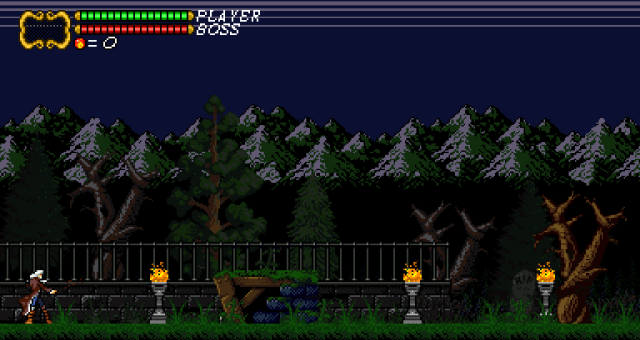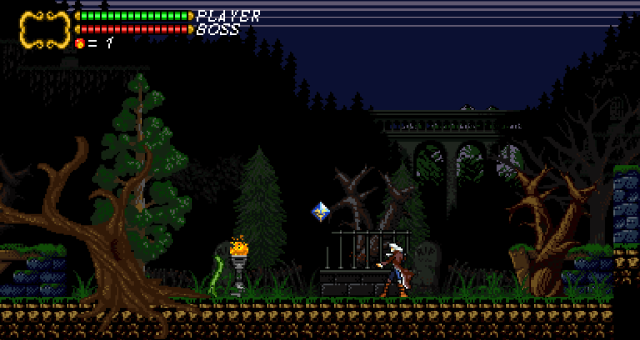When you take one look at Citadale: The Legends Trilogy (as I suggest you do in the trailer above), you know what you’re in for. By no means is this being pushed as some high-end title that’s going to bring some breathtaking new gameplay experience to Castlevania fans. This game is as raw and nostalgic as it looks at first glance.
Citadale: The Legends Trilogy is an indie Castlevania clone made by Ezekial Rage. It’s available on both the Wii U (£4.49) and Steam ($9.99). In Citadale: The Legends Trilogy, you play as Sonja Dorleac and wield a sword-like weapon called the Shadow Blade. You run and jump through this sidescroller killing off demons, zombies, bats, and all sorts of horrible-looking creatures. The “trilogy” in this title comes in the form of three in-game chapters which all play as slightly different games.
Chapter 1 is the original Wii U release, Gate of Souls. In Chapter 2, you play as Sonja’s son, Gabriel. In Chapter 3, Sonja’s grandson, Christopher, is given the Shadow Blade and you play his role . Like the game itself, the progression through chapters and the intertwining story is relatively simple.
A Shoddy First Impression
One thing worth noting right off the bat is that this trailer doesn’t do the game much justice. The tracks that they chose are far from the best you’re going to hear in Citadale: The Legends Trilogy, and I really wish they’d have picked better ones. I personally find the opening track of the trailer to be a bit hard on the ears, and that itself may be enough to turn people away. Try to hear past it.
Launching Citadale: The Legends Trilogy on Steam, you’re met with what is probably the most simple starting screen I’ve seen in the last few years. You can start playing the game or check out its (extremely limited) settings and options, shown here:

There’s no option to change your controls, which wouldn’t be an issue in a game where the controls were intuitive or introduced to the player in some tutorial mode or starting stage. But you don’t get that in Citadale: The Legends Trilogy. Through an hour of playing the game, I couldn’t figure out how to use my pick-up items. I pressed every key on my keyboard and came up empty. I searched on Google and found nothing. Being that this is one of the key mechanics in the game, I experienced it on a whole different level for first few bosses.
It was frustrating to see an axe in my inventory but not have any way to use it. Then finally, I remembered how you’d do it in the old Konami classic: Up + V/Alt. I feel really bad for anyone who doesn’t have experience with Castlevania games of the past, because figuring that out would be nearly impossible for them.
The only two other controls (other than movement through A/D or Left/Right) are your jump (C/Ctrl) and taking a swing of your Shadow Blade (V/Alt). You can crouch with S/Down.
Part of me gets the control thing, though. Citadale: The Legends Trilogy wants to be as raw as possible. It lends to the nostalgic and difficult experience, right? While I do agree, the level of keyboard-pounding required to figure everything out doesn’t exactly contribute to any sort of fun experience with the game.
Other than the lack of a way to change your controls, Old TV Mode is a neat option that adds a filter to your game to emulate those old TV scan lines.
Decent Visuals & Audio
Getting started with the game, you’re met with a few paragraphs of story. It’s very shallow and basic, but that’s to be expected in a game like this. Sonja is set out one night after her husband’s deceased father rises from his grave. Sonja’s husband takes off to check out a nearby citadel with his eyes set on stopping the evil forces his father has released, and Sonja is left behind to protect the village.

The graphics and audio were immediately a relief. Again, what I heard in the trailer wasn’t exactly pleasant to my ears. The track for the first stage of the game is much better and sounds exactly like something I’d expect from a Castlevania clone, so I have no complaints.
The sprites, both for Sonja and and enemies, are pretty fluid. I expected them to be more choppy and jerky than they are, so that was a nice touch to see.
One thing I will say is that, when looking through reviews of the game, I found two different occasions (here and here) where players made accusations of sprites and MIDIs being stolen and used for the game. In the second link, Ezekial Rage (the game developer) responds to say that he is aware of the strong similarities, although the report is representing something “not in this version of the game.”
Speculation aside, I think this just lends more to the fact that Citadale: The Legends Trilogy is trying as hard as possible to be a very close experience to the original Castlevania titles.
The Gameplay I Expected
All the way up until the first boss, which I got to within a matter of minutes, the gameplay was exactly what I thought it’d be. You hack and slash enemies to pick up coins, food, soul gems, and items. It’s nothing new, but that’s not necessarily a bad thing.

You’re also met with checkpoints throughout, at which you’ll respawn upon dying. This is extremely necessary because you can expect to die a lot. And that’s unfortunate, because it doesn’t tell you how to save your game anywhere — except in a line on the Steam page’s update notes that says F1 saves your state and F2 loads it.
You are only given one save state across the entirety of the game. If you close the game without pressing F1, when you launch the game again there is no option to continue. Your progress is lost. Before this update, players would need to beat through the entire game in one sitting. Talk about hardcore.
The first boss was a pretty cool experience. She (or at least I believe they were female) spawns in the center of the stage after you clear it on top of a rose. Periodically, she’ll cause the vines that you’ve been slashing through up until this point to spawn. It basically requires you to quickly learn the pattern where they spawn, kill them, and rush to the center of the stage where you can deal damage to her.
The next boss, which couldn’t have been more than five minutes away, was arguably even easier.

A dragon-like skeleton floats across the screen and you must jump and slash at him. When being hit, he’ll drop skeleton enemies that you’ve been fighting along the way. You quickly put them down and then get back to jumping and swinging at the boss. You won’t find yourself taking too much damage here.
From this point on though, you begin to experience a lot of new game mechanics. There comes a point where you’ll (probably) walk across a platform that has a slight discoloration to it, which will result in you falling to your death. Luckily enough, this happens just seconds after reaching a checkpoint. This is where the game begins to show a bit of cleverness and difficulty.
The next boss you’ll reach, which is just steps away from these falling platforms, is exponentially harder than the first two. I won’t spoil it for you, but you can expect to die many times before finally figuring it out.
The pick-up items that you’ll come across as you kill through giant spiders, slugs, and hordes or hideous monsters are as follows:
- Holy water, which burns enemies
- Throwing axes, which can damage enemies above you
- Throwing stars, which slice through multiple enemies in front of you
- Potions, which replenish your health
Each require a soul gem to use. Having no soul gems means you won’t be able to use your pick-up item. Think of the gems as mana. Players familiar with Castlevania should have no issue understanding this mechanic, nor will they experience the pains of figuring out what button combination allows you to use them (which, again, is Up + V/Alt).
A Few Shortcomings
While I admit I stopped one boss short of finishing Chapter 1, because I just couldn’t beat it after a good 30 tries, I can confidently state that one of Citadale: The Legends Trilogy‘s most glaring issues is the difficulty spike. I mentioned the boss from stage 3 being tenfold as difficult as the bosses from stages 1 and 2, and you’ll find this happening all throughout the game. You’ll cruise through a few stages and then just hit a wall. But this hardcore type of gameplay might be what some people are looking for.
Another issue I have with the game is that the hit detection is pretty mediocre, especially during some boss fights. Hits just don’t register as you would expect them to, which is a part of these nostalgic titles that we’d all rather forget than relive.
The skill cap in Citadale: The Legends Trilogy comes mostly from having experience in early Castlevania titles and being able to learn monster and boss fight patterns. The mechanics of your weapon aren’t very deep or difficult to learn. The only real quirk about it that you’ll have to play with is the way you’re able to jump, swing, and turn to hit in multiple directions at the same time with a single swing of the Shadow Blade. Other than that, don’t expect to impress yourself.
Conclusion
All in all, I think the people who will want to purchase Citadale: The Legends Trilogy are going to get what they wanted and expected out of it: a nostalgic, difficult experience that’s extremely similar to the old Castlevania games on NES. The story, sounds, visuals, and feel of the game are about as similar to the original Nintendo title as I’ve found.
Citadale: The Legends Trilogy boasts some replayability too. There are alternate endings for the first two chapters, and there’s even a boss rush mode for the original game if you manage to get the “good” ending. I can’t tell you how to achieve that, but it does add a little bit of hype to a game that has yet to receive Steam Achievements or things of that nature. I’m actually really curious to see what the boss rush game mode is all about and will probably work on it after this review.
If you’re a Castlevania fan or someone who just loves raw and classic hack-and-slash titles, Citadale: The Legends Trilogy won’t disappoint. For the majority of you though, you’ll find this title hard to fall in love with.
[Note: A copy of this game was provided by the developer for the purposes of this review.]






Published: Sep 28, 2017 10:38 am